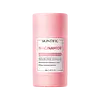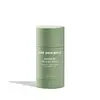What's inside
What's inside
 Key Ingredients
Key Ingredients

 Benefits
Benefits

 Concerns
Concerns

 Ingredients Side-by-side
Ingredients Side-by-side

Water
Skin ConditioningGlycerin
HumectantButylene Glycol
HumectantTitanium Dioxide
Cosmetic ColorantVolcanic Soil
Skin ConditioningMica
Cosmetic ColorantKaolin
AbrasiveNiacinamide
SmoothingDiglycerin
HumectantArbutin
AntioxidantSodium Palmitate
CleansingBeta-Glucan
Skin ConditioningPanthenol
Skin ConditioningMineral Salts
Skin ConditioningTranexamic Acid
AstringentSodium Hyaluronate
HumectantRhamnose
HumectantJojoba Wax PEG-120 Esters
PEG-40 Hydrogenated Castor Oil
EmulsifyingCI 77491
Cosmetic ColorantCI 77492
Cosmetic ColorantMenthyl Lactate
MaskingCI 45380
Cosmetic ColorantGlycyrrhiza Glabra Root Extract
BleachingPunica Granatum Fruit Extract
AntioxidantHydroxypinacolone Retinoate
Skin ConditioningPhenoxyethanol
PreservativeCaprylyl Glycol
EmollientAroma
Ethylhexylglycerin
Skin ConditioningDimethyl Isosorbide
SolventWater, Glycerin, Butylene Glycol, Titanium Dioxide, Volcanic Soil, Mica, Kaolin, Niacinamide, Diglycerin, Arbutin, Sodium Palmitate, Beta-Glucan, Panthenol, Mineral Salts, Tranexamic Acid, Sodium Hyaluronate, Rhamnose, Jojoba Wax PEG-120 Esters, PEG-40 Hydrogenated Castor Oil, CI 77491, CI 77492, Menthyl Lactate, CI 45380, Glycyrrhiza Glabra Root Extract, Punica Granatum Fruit Extract, Hydroxypinacolone Retinoate, Phenoxyethanol, Caprylyl Glycol, Aroma, Ethylhexylglycerin, Dimethyl Isosorbide
Water
Skin ConditioningKaolin
AbrasiveButylene Glycol
HumectantGlycerin
HumectantPropylene Glycol
HumectantDiatomaceous Earth
AbrasiveSodium Stearate
CleansingTitanium Dioxide
Cosmetic ColorantPEG-8
HumectantVp/Va Copolymer
CI 77288
Cosmetic ColorantSilica
AbrasiveCharcoal
AbrasiveCI 77492
Cosmetic ColorantMica
Cosmetic ColorantAlumina
AbrasiveChlorphenesin
AntimicrobialNiacinamide
SmoothingSalicylic Acid
MaskingArtemisia Argyi Leaf Extract
Skin ConditioningParfum
MaskingMenthol
MaskingCentella Asiatica Extract
CleansingPropanediol
Solvent1,2-Hexanediol
Skin ConditioningZinc PCA
HumectantNymphaea Caerulea Flower Water
Skin ConditioningLactobacillus/Rice Ferment
Skin ConditioningSalix Alba Bark Extract
AstringentBisabolol
MaskingPropolis Extract
Skin ConditioningCalendula Officinalis Flower Extract
MaskingCaprylhydroxamic Acid
Water, Kaolin, Butylene Glycol, Glycerin, Propylene Glycol, Diatomaceous Earth, Sodium Stearate, Titanium Dioxide, PEG-8, Vp/Va Copolymer, CI 77288, Silica, Charcoal, CI 77492, Mica, Alumina, Chlorphenesin, Niacinamide, Salicylic Acid, Artemisia Argyi Leaf Extract, Parfum, Menthol, Centella Asiatica Extract, Propanediol, 1,2-Hexanediol, Zinc PCA, Nymphaea Caerulea Flower Water, Lactobacillus/Rice Ferment, Salix Alba Bark Extract, Bisabolol, Propolis Extract, Calendula Officinalis Flower Extract, Caprylhydroxamic Acid
 Reviews
Reviews

Ingredients Explained
These ingredients are found in both products.
Ingredients higher up in an ingredient list are typically present in a larger amount.
Butylene Glycol (or BG) is used within cosmetic products for a few different reasons:
Overall, Butylene Glycol is a safe and well-rounded ingredient that works well with other ingredients.
Though this ingredient works well with most skin types, some people with sensitive skin may experience a reaction such as allergic rashes, closed comedones, or itchiness.
Learn more about Butylene GlycolCi 77492 is also hydrated iron III oxide. It's sole purpose is to give a yellow hue to products.
Iron III oxides are classified as inorganic chemicals for coloring.
Synthetically created Ci 77492 is considered safer than those naturally found. This is because the synthetically created version may contain less impurities. Iron oxides are generally non-toxic and non-allergenic.
Learn more about CI 77492Glycerin is already naturally found in your skin. It helps moisturize and protect your skin.
A study from 2016 found glycerin to be more effective as a humectant than AHAs and hyaluronic acid.
As a humectant, it helps the skin stay hydrated by pulling moisture to your skin. The low molecular weight of glycerin allows it to pull moisture into the deeper layers of your skin.
Hydrated skin improves your skin barrier; Your skin barrier helps protect against irritants and bacteria.
Glycerin has also been found to have antimicrobial and antiviral properties. Due to these properties, glycerin is often used in wound and burn treatments.
In cosmetics, glycerin is usually derived from plants such as soybean or palm. However, it can also be sourced from animals, such as tallow or animal fat.
This ingredient is organic, colorless, odorless, and non-toxic.
Glycerin is the name for this ingredient in American English. British English uses Glycerol/Glycerine.
Learn more about GlycerinKaolin is a clay. It is used for oil control and to help minimize pores. Like other clays, kaolin has the ability to absorb excess sebum or oil. This can help clean out pores and mattify the skin.
Some types of kaolin may have exfoliating properties. When water is added to kaolin, it becomes a paste with small abrasive particles.
Most kaolin is a white color, but may be pink/orange/red depending on where it comes from.
The name 'kaolin' comes from a Chinese village named 'Gaoling'. Kaolin clay comes from rocks rich in kaolinite. Kaolinite, the mineral, has a silicate layered structure. Kaolinite is formed from chemical weathering of aluminum siilicate minerals.
Besides skincare, kaolin is commonly used to make glossy paper, in ceramics, toothpaste, and as medicine to soothe stomach issues.
Learn more about KaolinMica is a naturally occurring mineral used to add shimmer and color in cosmetics. It can also help improve the texture of a product or give it an opaque, white/silver color.
Serecite is the name for very fine but ragged grains of mica.
This ingredient is often coated with metal oxides like titanium dioxide. Trace amounts of heavy metals may be found in mica, but these metals are not harmful in our personal products.
Mica has been used since prehistoric times throughout the world. Ancient Egyptian, Indian, Greek, Roman, Aztec, and Chinese civilizations have used mica.
Learn more about MicaNiacinamide is a multitasking form of vitamin B3 that strengthens the skin barrier, reduces pores and dark spots, regulates oil, and improves signs of aging.
And the best part? It's gentle and well-tolerated by most skin types, including sensitive and reactive skin.
You might have heard of "niacin flush", or the reddening of skin that causes itchiness. Niacinamide has not been found to cause this.
In very rare cases, some individuals may not be able to tolerate niacinamide at all or experience an allergic reaction to it.
If you are experiencing flaking, irritation, and dryness with this ingredient, be sure to double check all your products as this ingredient can be found in all categories of skincare.
When incorporating niacinamide into your routine, look out for concentration amounts. Typically, 5% niacinamide provides benefits such as fading dark spots. However, if you have sensitive skin, it is better to begin with a smaller concentration.
When you apply niacinamide to your skin, your body converts it into nicotinamide adenine dinucleotide (NAD). NAD is an essential coenzyme that is already found in your cells as "fuel" and powers countless biological processes.
In your skin, NAD helps repair cell damage, produce new healthy cells, support collagen production, strengthen the skin barrier, and fight environmental stressors (like UV and pollution).
Our natural NAD levels start to decline with age, leading to slower skin repair, visible aging, and a weaker skin barrier. By providing your skin niacinamide, you're recharging your skin's NAD levels. This leads to stronger, healthier, and younger looking skin.
Another name for vitamin B3 is nicotinamide. This vitamin is water-soluble and our bodies don't store it. We obtain Vitamin B3 from either food or skincare. Meat, fish, wheat, yeast, and leafy greens contain vitamin B3.
The type of niacinamide used in skincare is synthetically created.
Learn more about NiacinamideTitanium dioxide is a mineral UV filter widely used in sunscreens and cosmetics.
It is one of only two UV filters officially classified as “mineral” by regulatory agencies, the other being zinc oxide.
Titanium dioxide provides broad-spectrum protection mostly in the UVB and UVAII range, with some protection in the UVAI range.
While its UVA protection isn’t as strong as zinc oxide’s, the difference is minor.
A common myth is that mineral UV filters reflect UV light. However, modern research shows titanium dioxide absorbs UV radiation like chemical filters (~95% absorption & 5% reflection).
Thanks to its non-irritating nature, titanium dioxide is suitable for sensitive, acne-prone, or redness-prone skin. It is unlikely to cause "eye sting" like other sunscreen ingredients.
A major drawback of this ingredient is its white cast and thick texture. This is why mineral sunscreens often leave a white cast and are less cosmetically elegant than chemical/hybrid sunscreens.
To improve white cast and spreadability, micronized or nano-sized titanium dioxide is often used.
There are ongoing concerns surrounding nano-titanium oxide's impact on marine ecosystems.
There is no conclusive evidence that any form of titanium oxide (or any other sunscreen ingredients) will cause harm to marine ecosystems or coral reefs. The science is still developing but many consumers are keeping a close eye on this issue.
Please note, many destinations have reef-safety sunscreen rules. For instance, the U.S. Virgin Islands advises all visitors to use non-nano mineral sunscreens.
Nano mineral sunscreens once raised safety concerns about absorption into skin.
Extensive research has shown that they do not penetrate healthy or damaged skin; they remain safely on the surface and the top layer of dead skin (stratum corneum).
You'll likely find titanium dioxide bundled with alumina, silica, or dimethicone. These ingredients help make titanium dioxide highly photostable; this prevents it from interacting with other formula components under UV light.
Learn more about Titanium DioxideWater. It's the most common cosmetic ingredient of all. You'll usually see it at the top of ingredient lists, meaning that it makes up the largest part of the product.
So why is it so popular? Water most often acts as a solvent - this means that it helps dissolve other ingredients into the formulation.
You'll also recognize water as that liquid we all need to stay alive. If you see this, drink a glass of water. Stay hydrated!
Learn more about Water